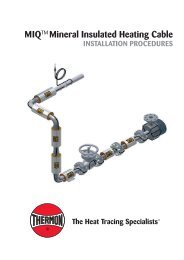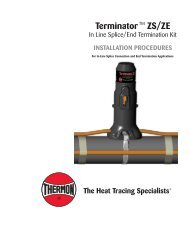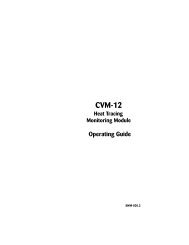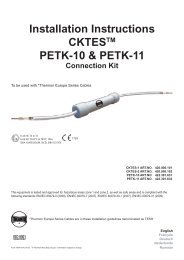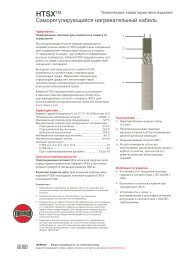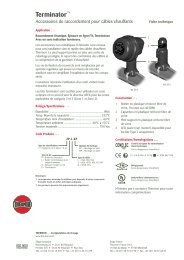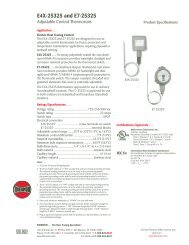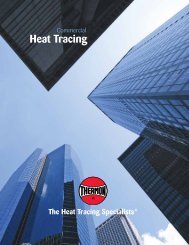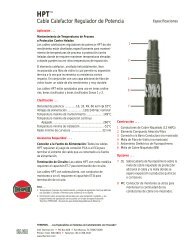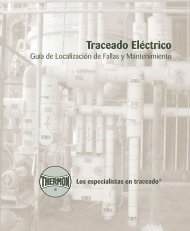Frost Heave Design Guide - Thermon Manufacturing Company
Frost Heave Design Guide - Thermon Manufacturing Company
Frost Heave Design Guide - Thermon Manufacturing Company
Create successful ePaper yourself
Turn your PDF publications into a flip-book with our unique Google optimized e-Paper software.
Freezer <strong>Frost</strong> <strong>Heave</strong> ProtectionIntroduction . . .The substrata of freezer floors can withstand cold temperaturesfor a period of time; however, the ground temperaturewill eventually drop below freezing. At that point, if water ispresent in the substrate, frost heaving of the freezer floor willoccur. FLX cables, when run in conduit in the substrate, providefrost heave protection by maintaining the ground temperatureabove freezing.Small or large frost heave protection applications can be easilydesigned utilizing FLX self-regulating heating cables. Establishingthe proper design, procurement and installation of materialsfor a project will ensure a successful heat tracing systeminstallation.The information contained within this design guide will assistengineers and contractors in establishing a successful electricheat tracing design and installation based on:Freezer temperatureAvailable power supplyFreezer sizeSubstrate makeupMonitoring/control requirementsAfter following the designated steps in this design guide, the engineer/contractorwill be able to design, specify or establish a billof materials for a freezer floor frost heave protection system.If design parameters are different than those in this designguide, contact your local <strong>Thermon</strong> factory representative foradditional information.Characteristics . . .Product Description . . .FLX self-regulating heating cable includes a parallel circuit constructionthat allows the cable to be cut to length and terminatedin the field. The semiconductive heating matrix providesthe self-regulating feature. FLX heating cable varies its heatoutput to compensate for the surrounding conditions along theentire length of a circuit.Whenever the heat loss of the freezer floor increases, the heatoutput of the cable increases. Conversely, when the heat lossdecreases, the cable reacts by reducing its heat output. Thisself-regulating feature occurs along the entire length of a heattracing circuit to ensure each point receives the requiredamount of heat while conserving energy.FLX 8 heating cables are rated for nominal heat outputs of5.5 W/ft in counduit at 40°F (18 W/m in conduit at 4°C)when powered at 110 to 120 Vac or 208 to 277 Vac. FLX selfregulatingcables include a tinned copper braid to providegrounding and polyolefin outer jacket for additional mechanicalprotection for the cable.Bus WireBus wire ..................................................................... 16 AWG nickel-plated copperHeating core ........................................................... radiation cross-linked polyolefinPrimary dielectric insulation ................................... radiation cross-linked polyolefinMetallic braid ..............................................12 AWG (equivalent size) tinned copperOuter jacket ......................................................................................... OJ, polyolefinMinimum bend radius ....................................................................... 1.25" (32 mm)Supply voltage ................................................................... 110-120 or 208-277 VacCircuit protection ...................................... 30 mA ground-fault protection requiredMax. operating temperature (power-on) .............................................. 150°F (65°C)Max. exposure temperature (power-off) .............................................. 185°F (85°C)Minimum installation temperature ....................................................... -60°F (-51°C)SemiconductiveHeating MatrixRadiation Cross-LinkedPolyolefin InsulationTinned Copper BraidPolyolefin Outer Jacket2



